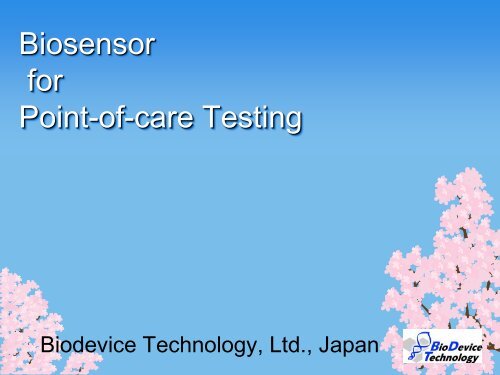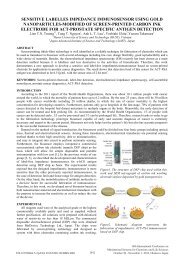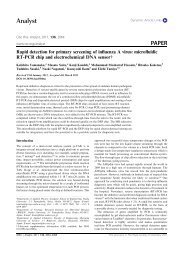Biosensor for Point-of-care Testing
Biosensor for Point-of-care Testing
Biosensor for Point-of-care Testing
You also want an ePaper? Increase the reach of your titles
YUMPU automatically turns print PDFs into web optimized ePapers that Google loves.
<strong>Biosensor</strong><br />
<strong>for</strong><br />
<strong>Point</strong>-<strong>of</strong>-<strong>care</strong> <strong>Testing</strong><br />
Biodevice Technology, Ltd., Japan
� About us<br />
� An enhancement assay <strong>for</strong><br />
immunochromatographic test<br />
� Disposable printed electrodes <strong>for</strong> biosensors,<br />
DEP-Chips, and their applications<br />
� immunosensor, GLEIA<br />
� Genosensor<br />
� Conclusion
BioDevice Technology, Ltd.<br />
BDT is a company born from Japan Advanced Institute <strong>of</strong> Science<br />
and Technology (JAIST) and was established in July 2003 by<br />
Pr<strong>of</strong>essor Eiichi Tamiya and five faculties.<br />
Capital 2 million yen, Employees 6<br />
Our Objects <strong>of</strong> Establishment<br />
・Establish products as fruits <strong>of</strong> research in<br />
universities.<br />
・Back up <strong>of</strong> making collaboration academic<br />
researchers with companies.<br />
・Build innovation by collaboration among<br />
academic, companies and government<br />
R & D <strong>of</strong> <strong>Biosensor</strong>s<br />
・High Sensitive Immunochromatography<br />
(PCT/JP2006/323617)<br />
・DEP-Chip series <strong>for</strong> electrochemical biosensors<br />
Gold-Linked Electrochemical Immuno Assay<br />
(GLEIA, PCT/JP2007/56992)
Applications<br />
Immunochromatographic Test Strip and Applications<br />
Clinical Diagnosis<br />
Pregnancy, cancer, infectious disease,<br />
cardiovascular problems etc.<br />
Food safety test<br />
Allergens, food toxins, GMO<br />
Ecological detection<br />
Endocrine disturbing chemicals<br />
Marketplace in Japan<br />
(2006)<br />
$250 million<br />
Influenza diagnosis kits<br />
in Japan<br />
$110 million<br />
Advantage:<br />
•User friendly <strong>for</strong>mat, easy to use<br />
•Rapid to obtain test result<br />
•Less interface due to chromatographic separation<br />
•Relative low cost<br />
Problem:<br />
• Relative low sensitivity around 1 ng/mL<br />
• Semi-quantitative<br />
Suit with screening or POC tests
Enhancement Assay <strong>for</strong> Immunochromatographic test strip<br />
antigen<br />
Nanogold labeled antibody<br />
Apply sample solution to a<br />
conjugation pad<br />
Conjugation pad<br />
Test line<br />
Control line<br />
Antigens react with nanogold- Antigen-antibody<br />
labeled antibodies and<br />
complex<br />
complex flow to capture antibodies<br />
Capture antibody on test line<br />
Antibody <strong>for</strong> control line<br />
(PCT/JP2006/323617)<br />
flow<br />
Absorption pad<br />
Normal strip Enhancer-based strip<br />
The complex <strong>of</strong> antigen and nanogold labeled antibodies accumulated and a higher amount <strong>of</strong><br />
gold nanoparticles in close proximity were brought in the enhanced test strip. As a result, higher<br />
Intensity <strong>of</strong> the localized surface plasmon resonance absorbance <strong>of</strong> the nanogold particles are<br />
able to obtain and a distinct red color can be easily observed.
Enhancement Assay <strong>for</strong> Immunochromatographic test strip<br />
Normal and the enhancer-based strips <strong>for</strong> the detection <strong>of</strong> hCG in PBS<br />
Normal strip Enhancer-based strip<br />
1000 10 Control 1000 10 Control<br />
100 1 100 1<br />
(pg/ml) (pg/ml)<br />
Control line<br />
Test line<br />
Intensity<br />
50<br />
40<br />
30<br />
20<br />
10<br />
0<br />
Normal 従来型ストリップ strip<br />
Enhancer-based strip<br />
金ナノ粒子固定化<br />
トリップ(1<br />
1000 100 10 1 Control<br />
Concentration <strong>of</strong> hCG (pg/ml)<br />
In PBS<br />
The lower limit <strong>of</strong> detection was 100pg/ml<br />
in the normal strip, whereas it was 1pg/ml<br />
in the enhancer-based strip.<br />
In serum<br />
The lower limit <strong>of</strong> detection was 100pg/ml<br />
in the normal strip, whereas it was 10pg/ml<br />
in the enhancer-based strip.
Our Applications<br />
Object Species Significance<br />
PSA human Prostate cancer marker 2 ng/mL<br />
hCG human Pregnancy maker 1 pg/mL<br />
Lower limit <strong>of</strong><br />
detection<br />
Insulin human Metabolic syndrome marker 125 pg/mL<br />
Hemoglobin human Gum disease marker 30 ng/mL<br />
HbA1c human Blood glucose level marker 0.25 ng/mL<br />
Ig E human<br />
Maker <strong>of</strong> allergy to cedar<br />
pollens, mite and cat hair<br />
Level 2<br />
sIgA canine Stress marker 20 ng/mL<br />
Cortisol human Stress marker 8 ng/mL<br />
Testosterone human Climacteric marker 125 pg/mL<br />
E. coli E. coli Microbial contamination OD600 0.3
Disposable Type Screen Printed Electrodes<br />
DEP-Chip Series<br />
Square working electrode<br />
SP-N, SP-P<br />
(carbon)<br />
SR-N<br />
(gold)<br />
Round working electrode<br />
Trial manufacturing <strong>of</strong> originally-designed<br />
screen printed electrodes<br />
EP-N<br />
(carbon)<br />
EP-PP<br />
(carbon, WE with ring and dam)<br />
ER-N<br />
(gold)
Cyclic voltammograms at 0.1 V/s (WE: carbon)<br />
3 mm<br />
Red line: 2 mM K3[Fe(CN)6] + 0.3 M Na2SO4<br />
Blue line: 0.3 M Na2SO4<br />
11 mm<br />
Ipa (anodic): 10.8 μA<br />
Epa (anodic): 0.163 V<br />
DEp:0.124 V<br />
3 mm<br />
Ipa (anodic): 10.8 μA<br />
Epa (anodic): 0.166 V<br />
DEp:0.141 V<br />
11 mm
Cyclic voltammograms at 0.1 V/s (WE: gold)<br />
Red line: 2 mM K3[Fe(CN)6] + 0.3 M Na2SO4<br />
Blue line: 0.3 M Na2SO4<br />
3 mm<br />
11 mm<br />
Ipa (anodic): 15.8 μA<br />
Epa (anodic): 0.107 V<br />
DEp:0.066 V
• Disposable<br />
Advantage <strong>of</strong> DEP-Chips<br />
• No contamination<br />
• Easy to use<br />
• Low cost<br />
• High quality CV < 5%<br />
• Small amount <strong>of</strong> reagents and samples 1-2 μL<br />
• Various applications <strong>for</strong> electrochemical<br />
determination<br />
� Especially suitable <strong>for</strong> biosensors
Gold-Linked Electrochemical Immuno-Assay<br />
(GLEIA, PCT/JP2007/56992)<br />
Gold nanoparticle redox signal enhancement <strong>for</strong> detection <strong>of</strong> antigens<br />
After the recognition reaction between the surface-immobilized primary antibody and hCG, the captured antigen<br />
was sandwiched with a secondary antibody that was labeled with gold-nanoparticles. Then the amount <strong>of</strong><br />
gold nanoparticles was determined by its redox signal.<br />
The primary antibody was Immobilized<br />
directly on the working electrode, and<br />
a sandwich-type immuno-reaction was<br />
per<strong>for</strong>med<br />
A high potential was applied<br />
In HCl <strong>for</strong> the oxidation <strong>of</strong><br />
gold nanoparticles<br />
The voltammetric measurement<br />
was per<strong>for</strong>med.<br />
DPV* : differential pulse voltanmetry<br />
Reference:<br />
• Direct fabrication <strong>of</strong> catalytic metal nanoparticles onto the surface <strong>of</strong> a screen-printed carbon electrode, Electrochemistry Comunications 8, p1375-<br />
1380 (2006).<br />
• Gold nanoparticle-based redox signal enhancement <strong>for</strong> sensitive detection <strong>of</strong> human chorionic gonadotropin hormone, Koutarou Idegami, Miyuki<br />
Chikae, Kagan Kerman, Naoki Nagatani, Teruko Yuhi, Taturo Endo, and Eiichi Tamiya, Electroanalysis 20, p14-21 (2008)
Current (μA)<br />
Application <strong>of</strong><br />
Gold-Linked Electrochemical Immuno-Assay I<br />
Typical differential pulse<br />
voltammograms <strong>of</strong> GLEIA.<br />
Potential (V)<br />
1000pg/m<br />
500pg/ml<br />
250pg/ml<br />
125pg/ml<br />
62.5pg/ml<br />
0pg/ml<br />
Human Chorionic Gonadotropin Hormone standard curves<br />
constructed with buffer (●) and with serum (●)<br />
Current (μA)<br />
2.0<br />
1.8<br />
1.6<br />
1.4<br />
1.2<br />
1.0<br />
0.8<br />
0.6<br />
0.4<br />
0.2<br />
0.0<br />
Sample vlume:1 – 1.5μL<br />
Lower detection limit: 62.5 pg/mL<br />
0 62.5 100 1000<br />
hCG concn. (pg/mL)<br />
control1 R 2 =0.9996<br />
serum R 2 =0.9971
Current (µA)<br />
Application <strong>of</strong><br />
Gold-Linked Electrochemical Immuno-Assay II<br />
1.2<br />
1.0<br />
0.8<br />
0.6<br />
0.4<br />
Insulin standard curve constructed with human serum<br />
R^2 = 0.99713<br />
0 100 300 1000<br />
Insulin (pg/mL)<br />
Sample vlume:1.4μL<br />
Lower detection limit: 125 pg/mL
DNA sensor<br />
Gene aggregation method(patent No.364257<br />
4)<br />
A B<br />
100nm 100nm<br />
(Low concentration <strong>of</strong> DNA<br />
or Be<strong>for</strong>e amplification)<br />
(High concentration <strong>of</strong> DNA<br />
or After amplification)
Application <strong>of</strong> DNA-sensor I by LSV<br />
invA gene <strong>of</strong> salmonella bacterium<br />
(PCR)<br />
M a b<br />
2.5<br />
1.5<br />
0.5<br />
1<br />
0.8<br />
0.6<br />
0.4<br />
0.2<br />
O157 gene (LAMP)<br />
M a b c d e<br />
2<br />
1<br />
negative<br />
0<br />
100 200 300 400 500 600 700<br />
negative<br />
positive<br />
positive<br />
0<br />
100 200 300 400 500 600 700<br />
a<br />
b<br />
c<br />
d<br />
e<br />
Genetically-modified corn (LAMP)<br />
M a b c<br />
2.5<br />
2<br />
1.5<br />
1<br />
0.5<br />
M a b c<br />
0<br />
200 300 400 500 600 700 800<br />
2<br />
1.6<br />
1.2<br />
0.8<br />
0.4<br />
negative<br />
Hepatitis B virus gene from blood<br />
sample (Nested PCR)<br />
negative<br />
positive<br />
positive<br />
0<br />
200 300 400 500 600 700 800<br />
a<br />
b<br />
c<br />
a<br />
b<br />
c
Application <strong>of</strong> DNA-sensor II<br />
Many people have tried to develop techniques to detect and identify species<br />
origin especially in food products during the last decades which are very<br />
important due to the Economic, Health, and Religious issues.<br />
Pork contents as a food<br />
Raw meat Raw sausage Raw lard Coocked<br />
sausages
Application <strong>of</strong> DNA-sensor II<br />
Electrochemical genosensor <strong>for</strong> the detection <strong>of</strong> pork’s 12S rRNA gene<br />
using chronoamperometry (CA)
Conclusion<br />
� The sensitivity <strong>of</strong> our immunochromatographic tests is at least<br />
several times higher than those <strong>of</strong> conventional tests.<br />
� DEP-Chips are suitable <strong>for</strong> POCT because <strong>of</strong> their ease to use,<br />
low cost, disposability, economy <strong>of</strong> reagents and samples.<br />
� GLEIA with DEP-Chips is a new sensitive immunoassay and will<br />
provide a new POCT.<br />
� Genosensors with DEP-Chips can determine the existence <strong>of</strong><br />
target genes within 5 min after amplification by PCR or LAMP.<br />
The genosensor will provide a new POCT <strong>for</strong> safe <strong>of</strong> foods and<br />
environments etc.<br />
Contact in<strong>for</strong>mation: Hiromi Ushijima,<br />
TEL/FAX +81-761-51-7210<br />
postmaster@biodevicetech.com




